We put a dozen different brands of top-rated diapers through extensive testing and hours of study to determine what materials make the best diaper, revealing a few standout winners. It was clear that the Huggies Little Snugglers and Pampers Baby Dry Diapers were the best diapers overall, as they always kept leaks from happening and fit kids of all sizes the best. My daughter was 8 months old when testing, and three other parents put these diapers—along with other top-performing options, including numerous popular subscription-service diapers—through their paces with four children ranging in age, gender, weight, and stage of development, from 4 months to 4 years old. Fortunately, we found nine more brands whose diapers were best for certain families or situations.
Of course, every parent dreams of the day their kids will no longer need diapers. Along with the blowouts, leaks, diaper pails full of soiled diapers, and the continual, slight stench of pee, there are other issues to consider, such as the overwhelming expense of purchasing all the diapers your child will require for their early years. People who have kids spend a lot of time, money, and effort on diapers. So I set out to find the best diapers to make that easier for parents.
Given everything you’ve read in this post, you might want to go out and get some top-notch diaper cream to avoid rashes and some top-notch diaper bags to carry all your necessities. If you are in the process of preparing the nursery for a new baby, you should also consider purchasing one of our favorite changing tables.
- Best Overall Pick: Huggies Little Snugglers Diapers
- Best Budget: Pampers Baby Dry Diapers
- Best for Newborns: The Honest Company Clean Conscious Diapers
- Best for Sensitive Skin: Bambo Nature Diapers
- Best Value: Coterie Baby Diapers
- Best for Day and Night: Mama Bear Gentle Touch Diapers
- Best for Overnight: Pampers Swaddlers Overnight
- Best for Active Babies: Huggies Size 4 Diapers
- Best for Eco-Conscious Parents: Kirkland Signature Diapers
1. Best Overall Pick: Huggies Little Snugglers Diapers
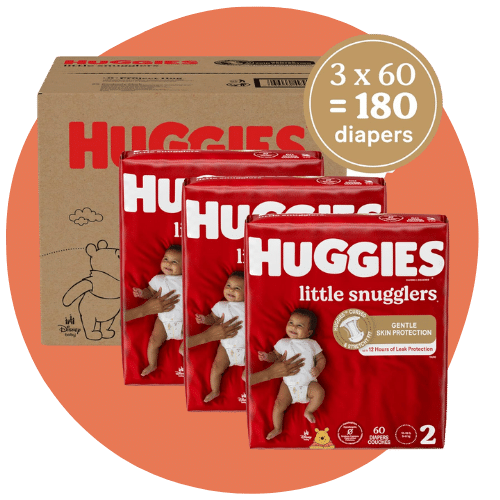
Even when they blow out, Huggies Little Snugglers are a fantastic option for someone seeking ones that don’t leak. However, how exactly does it manage the blowouts? It features a wetness indicator, an extremely absorbent liner, and a blowout-blocker waistband. The curved, stretchy fit also keeps the baby flexible without cleaning the mess, and they can still do some activities even if the diaper is wet. The brand also claims to be completely fragrance-free. This diaper’s extra soft material not only comforts the baby but also shields them from the red lines diapers create during tummy time. It’s hypoallergenic and tested by a dermatologist. It’s free from elements like chlorine or lotions. Disney Winnie the Pooh is one of the company’s favorite baby cartons. Finally, Huggies diapers are available in a variety of sizes so you won’t face any hassle.
Pros
Cons
2. Best Budget: Pampers Baby Dry Diapers
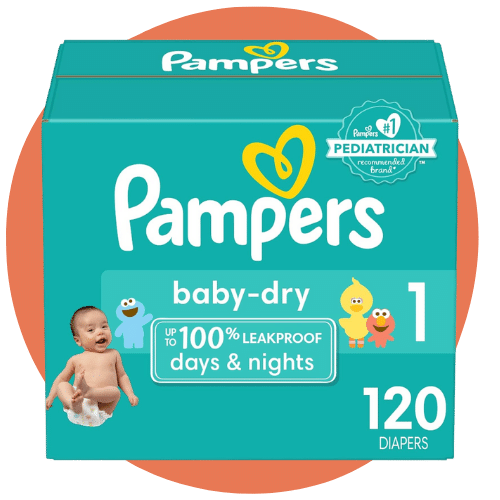
A baby’s good sleep also depends on the diaper they have. Pampers baby dry diapers are completely leakage-proof, making the baby’s morning more refreshing. The Dri-Weave Liner in the diaper helps keep the baby’s skin safe and secure from sensitivity. In addition to being highly hypoallergenic, it also comes without any side effects. Customers’ trust begins when they learn that it’s also the #1 pediatrician-suggested brand. The wetness indicator is also there to save you from guessing games. The stretchy sides and large tape fasters help secure the fit while comforting. The company also ships 100% recyclable packaging. It’s a good choice for fecal and urine protection. Materials such as latex, chlorine, and parables are not included because they can harm the baby’s sensitive, soft skin. The fun prints on the diaper can bring a little excitement to children while they are wearing it.
Pros
Cons
3. Best for Newborns: The Honest Company Clean Conscious Diapers
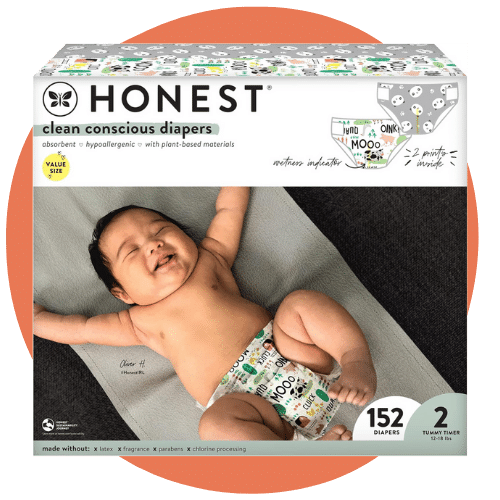
The Honest Company’s eco-friendly diapers not only save 700 trees but also improve performance right away because of features like improved absorption, blowout protection, an indicator of the witness, and extreme comfort. The Honest Company specifically designs the features for each baby stage. The diapers are safe to use because they don’t contain any additives, latex, or unnecessary fragrances. The process that gets used to make these unique diapers is harvesting the wood from sustainable, well-managed pine + spruce trees in Scandinavia, and then it gets turned into soft pulp in Sweden with no chlorine in it. How can we harm those little animals, such as babies, just to test the product? Despite its safety, the product has not undergone animal testing. The bonus is that you can even recycle the Diaper Box easily.
Pros
Cons
4. Best for Sensitive Skin: Bambo Nature Baby Diapers
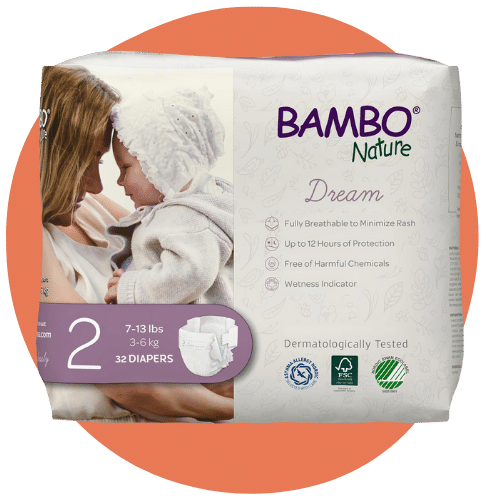
You can guess it by name, yes, they are eco-friendly, but more than that, they are the first ones who are certified with the Nordic Swan Ecolabel. The diapers are fully chlorine-free. The diaper has three layers in it, and the core layer is for handling all the wetness, even overnight. Combined with the fully breathable back sheet, the baby’s skin will feel comfortable and dry. The Bamboo Nature brand has been in a sustainability-manufactured area for a very long time, which makes it more trustworthy. The color-changing indicator helps identify the right time to change the diaper. Latex-free leg cuffs and the waistband help diapers stay in place when the little one is doing fun activities. It has the thinnest design to avoid discomfort and prevent leakage. It can provide protection for more than 12 hours. The packet contains 32 diapers, ranging in size from 3 to 6 kg.
Pros
Cons
5. Best Value: Coterie Baby Diapers
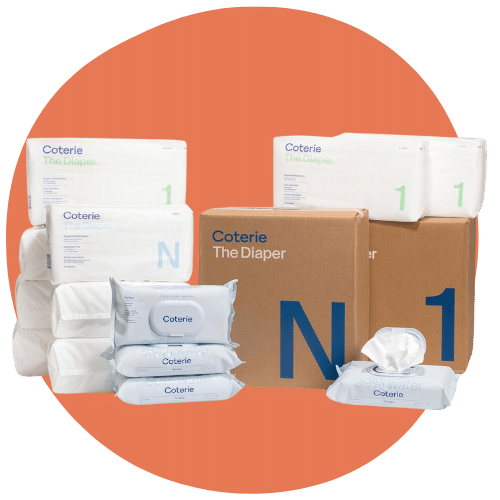
The Coterie baby diapers, designed specifically for newborns to maintain soft skin, have a 70% larger liquid capacity. It provides more than 12 hours of overnight protection, as well as 4x faster absorption. The ruffled leg cuffs are used to limit the blowout, and they’re free from any fragrance or alcohol. Its witness indicator makes it more beneficial to use. The diaper is 25% plant-based. Experts have approved the diapers, and parents have already expressed their love for them. Because all of the fiber in the wipes that Coterie Company offers is derived entirely from plants, they are excellent and extremely soft for babies to use. Furthermore, it is specifically designed to protect infants’ delicate, small skin. The diaper box includes the wipe kit and diaper.
Pros
Cons
6. Best for Day and Night: Mama Bear Gentle Touch Diapers
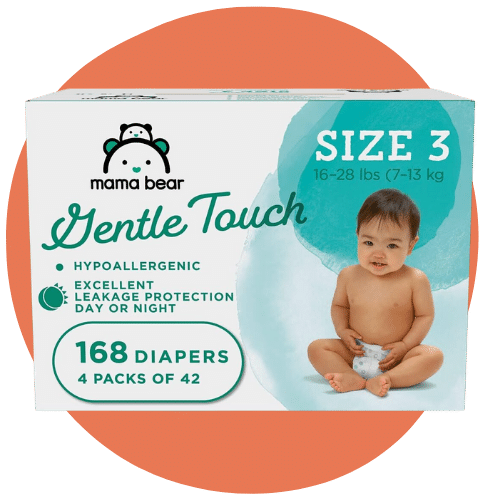
Reliable certification attests to the sustainability aspects of the Mama Bear brand. Included is leak protection and comfortable, all-day use. The fit is incredibly secure for all of the kid’s activities, including playing. Its airy outer cover and hypoallergenic construction contribute to the baby’s comfort. The thin fit of the diapers will not cause any issues for the child while wearing them. It does not contain any toxins, such as chlorine, nor does it contain perfumes, lotions, parables, or phthalates that can irritate the baby. They also recommend the perfect size for the child, such as a newborn up to 10 lbs. or a size 5 up to 27+. The packet comes with 4 packets of 42 diapers. It is safe for the environment, as well as for the baby, a small child.
Pros
Cons
7. Best for Overnight: Pampers Swaddlers Overnight

When it comes to choosing diapers for the baby, Pampers is a very popular brand, as well as their Pampers Swaddlers Overnight and it’s popular for some reason. The diaper is 100% leakproof, and it absorbs water so that the skin is not affected until the diaper is changed. It includes a blowout barrier. The diapers are made entirely of latex and contain no plastic. The breath-free liner helps take wetness away from the skin. It has dual leak-guard barriers, so even if the baby moves a lot, the leakage would not be a problem. The package contains 58 full diapers. The one item weighs 3.92 pounds, and the weight range of the diaper is 22–37 lbs.
Pros
Cons
8. Best for Active Babies: Huggies Size 4 Diapers
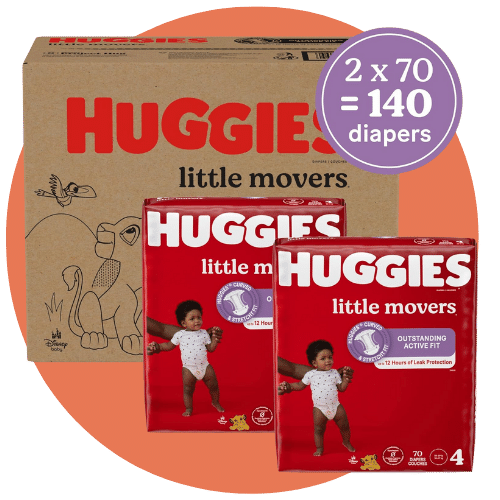
To get the ideal one for the baby, all you need is the Huggies Size 4 diapers, but people also say Little Movers baby diaper. Moreover, the diapers are hypoallergenic and entirely leak-proof, even in size 4. Dermatologists have tested the diaper, and it comes from a brand that is completely fragrance-free to avoid irritating a baby’s sensitive skin. It’s a blowout blocker that made the original leak lock. The diaper features a specially designed size 4 design that allows the baby to move without any problems. The diaper has a very cool design, which also includes a wetness indicator. The good thing about the brand is that if you find any issues, you can just tell them, and they will work on them to make the product better for the babies.
Pros
Cons
9. Best for Eco-Conscious Parents: Kirkland Signature Diapers
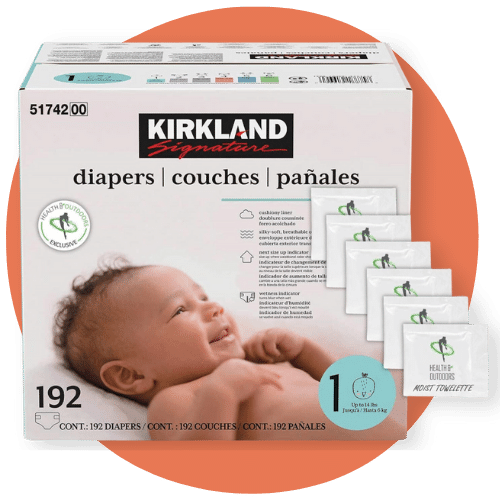
Kirkland Signature sells one of the coziest and most reliable diapers for children. It’s made up of planet-based materials, which not only make it safe to use but also soft and absorbent. It’s hypoallergenic. The interesting thing is that the wetness indicator turns blue as the diapers get wet, indicating when it’s time to change. An indicator on the waistband allows you to determine the child’s ideal size over time. For example, Size 1 is a great choice for 14 lbs. and comes with 192 diapers. The Kirkland diaper box contains 192 diaper sets and the six best towelettes. The moist towelettes will help you clean your baby more hygienically and safely. The product is not gender-satisfying, so no matter if you have a baby boy or girl, you can go for this one. You don’t need the batteries for the indicators, either; they will stay until the diaper of the baby gets wet.
Pros
Cons
Test and Analysis of the Best Diapers?
This is what the best diaper for a newborn to a toddler should have:
Capable of absorbing
In summary, parents demand diapers that are leak-proof. I’ve tested a lot of diapers, and this requirement is harder to meet than I thought it would be. But the ideal diaper should have three strips along the crotch that soak up liquid slowly. An ideal diaper should be able to hold at least 2 cups of liquid, ideally 1 cup, without soaking through. It’s good for your health to avoid getting too wet because it can lead to diaper rash.
Fits well
Fit is also a factor in leaks. A poorly fitting diaper can cause leakage due to the gaps between your child’s legs and the diaper, as well as the spaces around their waist. To ensure a good fit, the tabs should be well-made to stay closed around the child’s waist. “There’s nothing worse than coming home to a naked baby in the crib who is wet with pee or poo.” I found that diapers made of easily stretchable materials provided the best fit.
By the way, if you like a brand of diaper, but it starts to leak, you need to get a bigger one. Over the years, parents have shared a lot of stories about how they size up for overnight diapers so that mistakes happen less frequently at night.
Comfortable
What makes a good diaper? It should be soft and comfortable on your child’s legs and waist, as well as not irritate their skin. Some of the less expensive diapers I tried were not soft, and as a result, they left red marks along my daughter’s legs. This is not something I would recommend. Also, diapers should keep your baby’s skin dry so they don’t get the rash.
Secure
When your baby wakes up from a nap, you find them naked, with their diaper hanging off their leg. (Cue a loud groan from a parent.) If you want your diaper to stay put, look for one with long-lasting tabs that you can tie around your baby’s waist. The cheaper diapers I tried kept coming undone, but the best ones stayed in place during long naps and trips outside. When it comes to tabs, Velcro is usually the way to go.
Simple to Find
At this time, there is a significant shortage of a variety of products, and diapers are not an exception. Before putting together the testing study, I researched a few diapers, but some were either sold out or difficult to purchase online. Finding a diaper or having it delivered to your door through a monthly service is one of its best features. When making our choices, we put this at the top of our list.
Wetness Indicator
Having to remove your child’s diaper each time you suspect that they need a fresh one would be a hassle that you would not want to experience. The wetness indicator is a simple but very useful tool. There’s a strip on the front of the diaper that changes color when it gets wet and stays the same color when it’s dry. It’s quick and easy to check to see if it’s time to change the diaper.
Skin sensitivity and hypoallergenic materials
Babies’ skin is extremely sensitive, which is why diaper designers design them to be soft. But if you’ve seen that your child is having reactions, or if you just want to avoid a problem before it happens, look for the best diapers for sensitive skin. When a brand says that its products are hypoallergenic, it means that it’s not likely that those goods will cause an allergic reaction.
Types of Diapers and How To Choose
Parents will require diapers unless they want to clean up messes everywhere their baby goes. Picking a good product can be hard because it involves more than just finding one that fits your price. More resources than ever before exist to help you choose the best diapering product, thanks to rising interest in eco-friendly options and a surge in the use of cloth diapers. How do you pick? How can you determine what’s best for your lifestyle? No matter what your goals are for the diaper years, we believe there is a diaper that will work for you.
Before potty training, a baby typically goes through 6,000 to 9,000 diapers, which equates to almost 2,500 diapers in the first year! This results in significant financial expenditure to cover baby bottoms and manage messes. For these reasons, a lot of parents think about using cloth diapers or other environmentally friendly choices to save money and help the environment.
Disposable diapers
Today, many parents still choose disposable diapers as their baby’s diapering option. They are definitely useful to use and throw away, whether you are at home or on the go. You can also easily locate and buy them. Disposable diapers are cheaper than cloth diapers, and families with them can just throw them away without washing or cleaning them. But none of the diapers we tried are perfect. Throwaway choices take up a lot of space in landfills, cost a lot over time, and you might run out in the middle of the night if you don’t have a backup plan.
It’s not easy to test disposable diapers. We fully evaluate the best disposable diapers on the market using research, in-house lab tests, and real-life data from our little testers. Over 32 tests, including 5 fake urine tests, are given to each competitor in the disposable competition to see how well they do.
Since 2012, everything we’ve tried in-house on disposable diapers has different amounts of SAP (Super Absorbent Polymer). SAP is what makes a disposable’s absorbent core layer so effective at soaking up moisture. It’s interesting that some green diapers do better than average at absorbing liquid, and some regular diapers do worse. We appreciate that some disposable options prioritize environmental friendliness in their manufacturing process.
Cloth diapers
It’s becoming more popular to use cloth diapers, which were the only choice before disposable diapers came out. Modern styles of cloth diapers come with inserts or other features that make them easier to clean, which makes them more easy to use. Cloth costs more at first, but if you choose a style that grows with your baby, it could save you money in the long run. Cloth diapers require daily washing with top-notch baby detergent, or more frequently if you have enough. They’re also big, which might make it hard to wear some clothes with them. Finally, if you change a baby’s diaper somewhere other than home, you have to put the dirty cloth in a bag and carry it until you get home.
Babies in the first few years of their lives go through a lot of changes and poop, so it’s important to have diapers that can handle that. One of the best things about using cloth is that you can customize how much moisture you need and how it fits. Based on our many years of experience with cloth diapers and test results, we know that not all of them work the same. Things like gussets, the ability to change the waistband, the type of material used, and other design elements make a big difference in how well they work.
In our in-house lab, the cloth competition goes through more than 22 separate tests to compare and analyze performance in each metric and total. These include three fake urine tests to see how they handle and conceal moisture. We also conduct research and tests with real babies to gain knowledge of the real world. Our expertise provides you with the information you need to make the best decision for your family.
Overnight diapers
It’s possible that a top-rated overnight diaper can make the difference between a good night’s sleep and multiple urine-soaked changes of clothes, which can mean changing your baby’s favorite crib bedding several times and being tired the next day. In that case, what’s the point of sleeping products? Some cloth and disposable options got very high marks on our absorbency tests, but they are only meant to be used during the day and can’t handle the extra urine that comes out at night. For babies and children who make more urine and wear diapers that are a size three or up, our overnight diaper review is mostly about how well they absorb stools.
Each overnight candidate goes through more than 24 separate tests, three of which are to see how well they absorb water. We can rate and compare the products based on their overall success and the metrics we use. When it comes to overnight diapers, we use more fake pee than with other types. During a single night of sleep, a child weighing 22 pounds sheds approximately 200 milliliters of urine on average. Other than this change, the testing process has remained the same.
Based on our tests, we know that some competitors have trouble absorbing and wicking away moisture, as shown by the filter paper results. Science-grade filter paper feels like a baby’s skin. You may see how much liquid stays close to the baby’s skin instead of being trapped in the diaper’s inner core by looking at how much moisture is absorbed into the filter paper by the surface layer of the pretend pee.
Frequently Asked Questions
As a parent, how many diapers do you go through?
As a general rule, Dr. Stella tells parents to expect their child to need 10 diapers a day. In the baby stage, that can add up to 40–70 diapers a week.
How can I identify if some diaper materials are too harsh for my baby?
Dr. Shaikh says that a rash that won’t go away, swelling, peeling skin, and marks on the skin in the diaper area could be signs of a reaction to the diaper materials. Baby’s skin is very sensitive at birth, so they may outgrow a problem with a certain diaper brand. See a doctor about any diaper rash or irritation problems that aren’t going away.
What size diapers should I get for my first child?
If your baby was born earlier than expected or weighs less than 6 to 7 pounds, a baby-size diaper may be the best choice. Fully grown babies or those weighing more than 7 pounds should fit into a newborn-size diaper. A size 1 diaper might be best for babies that weigh 8 pounds or more.
Should a diaper be flexible or tight?
Be flexible! Take a look at tensile strength, which tells you how well a diaper can bend and stretch without losing its shape. When a baby starts to move around a lot, their diaper needs to be able to stretch and move with them. If it doesn’t, it will either leak or fall off. Even though it’s important all over the diaper, the back bands that go around your child’s waist are the most important. It might be easier for a diaper that isn’t very strong to come off, and the buttons often come off the diaper itself when you’re trying to put it on.
Bottom Line
Choosing the best diapers for your baby can be hard and confusing if you don’t know much about diapers. To help you find the best diaper for your baby, your goals, and your budget, we’ve put a lot of work into making sure that our side-by-side reviews are fair, objective, and useful. We tried traditional disposable diapers, cloth diapers, green disposable diapers, and add-in covers to see what makes one better than another for different reasons, such as being better for the environment, being more absorbent, or both. We are sure that this line of great, award-winning goods has something for everyone and every need, whether you are looking for a great clothing product, a better-absorbent disposable product, or something cheaper and better for the environment.



